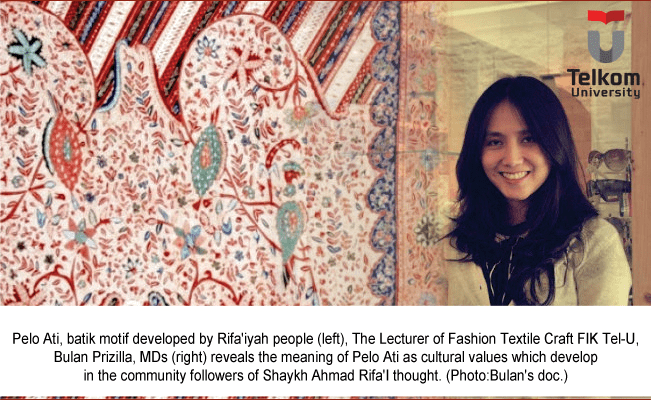BANDUNG, TEL-U – The design of Batik Pelo Ati. The decoration engrave two motifs of chicken with its head cut off. In part of the body shows ornament resembles the shape of heart, and the other chicken pattern is pelo. This is one characteristic of Rifa’iyah batik patterns. This coastal batik influenced by culture of Rifa’iyah people who cohere to the thought of Syaikh Ahmad Rifa’I air-Shafi’i madhhab.Following the Islamic Shari’a, Rifa’iyah Batik deflectsanimal or human element. Even though there is an element, it will not be entirely draw but certain parts of the body. For example, only a partial picture of the body itself or decorate it with pictures of plants. It is because the characteristics of Pelo Ati described with motifs of flowers and foliage. Revealing philosophical of Pelo Ati, lecturers and researchers of Textile Craft Fashion
Telkom University, Bulan Prizilla, M.Ds define that decorative Pelo Ati has deep meaning of Shaykh Ahmad Rifa’i thought about Sufism.”Chicken on batik Pelo Ati likens living creatures. And man is a living creature with the heart inside. In Tarajumah book, there are eight human natures mentioned ascetic, qana’at, patient, trust, persistent, willingness, gratitude and sincere, “said Bulan, Thursday (19/3).Pelo Ati decoration also portray another deep meaning image such as a bird gizzard depicted outside the body of the bird. Bulan said, gizzard is a place for dirt and must be discarded. She also revealed, gizzard picture likens human vices that must be removed. Tarajumah book mentioned about human vices which are hubbu al-dunya, Thama ‘(greedy), itba’ al-hawa, ‘ujub (smug), riya (show off), takabur (arrogant), hasud and sum’ah.
“Batik Pelo Ati Rifa’iyah apply staining Tiga Negeri, where these colors symbolize the life principle of Rifa’iyah people namely Ushuliddin, Fiqh and Mysticism,” said Bulan.
She also explained, Islamic law implemented by Shaykh Ahmad Rifa’i, prohibits the depiction of living creatures other than plants on clothing. Unless the animal is on the death condition. For example exhibit the head cut off or cut other body parts that symbolize the animal is dead. It is intended that the batik artwork does not give rise to shirk for creators and users. It is because Islam has the rules that must be followed in the depiction, particularly the depiction of his creatures. It is clearly appears on Pelo Ati Rifa’iyah design.
The influence of Islamic law is strongly manifested in the art of Rifa’iyah batik patterns. According to Bulan, mostly Rifa’iyah Batik is based on the thought of Shaykh Ahmad Rifa’i, a founding father of Pesantren Kalisalak, Limpung Batang. Rifa’iyah title is taken from the name of the congregation founded by KH. Rifa’i Ahmad where the community appears in Kalisalak, Batang, Central Java around 1850. Shaykh Ahmad Rifa’ialso listed as one of the national heroes since President Susilo Bambang Yudhoyono until today.
“Most of Batik Rifa’iyah have a stunning artistic value. The motif and pattern is very adhesive with Islamic values and cultural values of community life, “added Bulan. (Purel / Risca)

